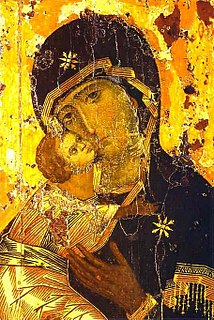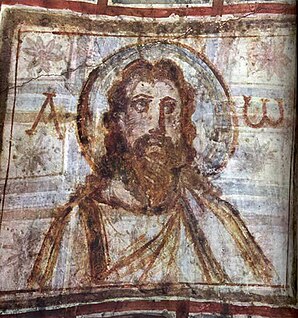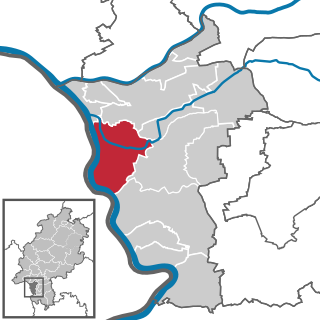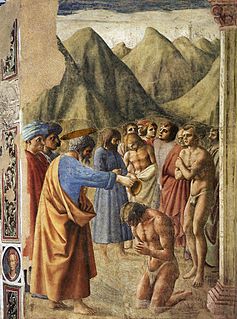
Mary was a first-century BC Galilean Jewish woman of Nazareth, and the mother of Jesus, according to the New Testament and the Quran.

The Imitation of Christ by Thomas à Kempis is a Christian devotional book. It was first composed in Latin ca. 1418–1427. It is a handbook for spiritual life arising from the Devotio Moderna movement, of which Kempis was a member.

In Christianity, Jesus is believed to be the Son of God and the second Person of the Holy Trinity. Christians believe that through his crucifixion and subsequent resurrection, God offered humans salvation and eternal life. He is believed to be the Jewish messiah prophesied in the Hebrew Bible and Christian Old Testament. These teachings emphasize that as the Lamb of God, Jesus chose to suffer on the cross at Calvary as a sign of his obedience to the will of God, as an "agent and servant of God". Jesus died to atone for sin to make us right with God. Jesus' choice positions him as a man of obedience, in contrast to Adam's disobedience.

Kyrie, a transliteration of Greek Κύριε, vocative case of Κύριος (Kyrios), is a common name of an important prayer of Christian liturgy, also called the Kyrie eleison.

Gaudete Sunday is the third Sunday of Advent in the liturgical calendar of the Western Church, including the Roman Catholic Church, the Anglican Communion, Lutheran Churches, and other mainline Protestant churches. It can fall on any date from 11 December to 17 December.
Devotio Moderna, or Modern Devotion, was a movement for religious reform, calling for apostolic renewal through the rediscovery of genuine pious practices such as humility, obedience, and simplicity of life. It began in the late fourteenth-century, largely through the work of Gerard Groote, and flourished in the Low Countries and Germany in the fifteenth century, but came to an end with the Protestant Reformation. It is most known today through its influence on Thomas à Kempis, the author of The Imitation of Christ, a book which proved highly influential for centuries.

Divine Mercy Sunday is celebrated on the Sunday after Easter, the Octave Day of Easter. The feast day is observed by Roman Catholic as well as some Anglicans. It is originally based on the Catholic devotion to the Divine Mercy that Saint Faustina Kowalska reported as part of her encounter with Jesus, and is associated with special promises from Jesus and indulgences issued by the Church
A penitential is a book or set of church rules concerning the Christian sacrament of penance, a "new manner of reconciliation with God" that was first developed by Celtic monks in Ireland in the sixth century AD. It consisted of a list of sins and the appropriate penances prescribed for them, and served as a type of manual for confessors.

In Christian theology, the Imitation of Christ is the practice of following the example of Jesus. In Eastern Christianity, the term Life in Christ is sometimes used for the same concept.
Penitential canons are religious rules laid down by councils or bishops concerning the penances to be done for various sins. These canons, collected, adapted to later practice, and completed by suitable directions formed the nucleus of the Penitential Books .
God in Christianity is the eternal being who created and preserves all things. Christians believe God to be both transcendent and immanent. Christian teachings of the immanence and involvement of God and his love for humanity exclude the belief that God is of the same substance as the created universe but accept that God's divine nature was hypostatically united to human nature in the person of Jesus Christ, in an event known as the Incarnation.

In Roman Catholic Mariology, the title Mediatrix refers to the intercessory role of the Blessed Virgin Mary as a mediator in the salvific redemption by her son Jesus Christ, and that he bestows graces through her. Mediatrix is an ancient title that has been used by a number of saints since at least the 5th century. Its use grew during the Middle Ages and reached its height in the writings of saints Louis de Montfort and Alphonsus Liguori in the 18th century.
The Militia of Jesus Christ was a military order in Lombardy during the High Middle Ages. It was founded at Parma by Bartholomew, Bishop of Vicenza, a Dominican, in 1233 and approved by Pope Gregory IX, who gave it a rule in 1234 and placed under the jurisdiction of the Dominicans. Its chief purpose was to combat heresy, like Catharism and Waldensianism, and to strengthen the bond between the Roman Church and the local nobility. In imitation of the Order of Santiago, members of the Militia did not take a vow of chastity, nor did they live communally or in poverty.

Mariology is the theological study of Mary, the mother of Jesus. Mariology methodically relates teachings about her to other parts of the faith, such as teachings about Jesus, redemption and grace. Christian Mariology aims to connect scripture, tradition and the teachings of the Catholic Church on Mary. In the context of social history, Mariology may be broadly defined as the study of devotion to and thinking about Mary throughout the history of Christianity.

The history of Catholic Mariology traces theological developments and views regarding Mary from the early Church to the 21st century. Mariology is a mainly Catholic ecclesiological study within theology, which centers on the relation of Mary and the Church. Catholic Mariology is the encyclopedic area of theology concerned with Mary, the Mother of God. Theologically, it not only deals with her life, but her veneration in daily life, prayer, art, music, architecture, in modern and ancient Christianity throughout the ages.

Throughout history Roman Catholic Mariology has been influenced by a number of saints who have attested to the central role of Mary in God's plan of salvation. The analysis of Early Church Fathers continues to be reflected in modern encyclicals. Irenaeus vigorously defended the title of "Theotokos" or Mother of God. The views of Anthony of Padua, Robert Bellarmine and others supported the doctrine of the Immaculate Conception of the Virgin Mary, which was declared a dogma in 1850.
Redemption is an essential concept in many religions, including Judaism and Christianity. The English word "redemption" means 'repurchase' or 'buy back'.

The Prayer of Consecration to the Sacred Heart is a Roman Catholic prayer composed by Pope Leo XIII. It was included in the 1899 encyclical Annum sacrum issued by Leo XIII as he consecrated the entire world to the Sacred Heart of Jesus.

Josephology is the theological study of Saint Joseph, the husband of Mary, mother of Jesus. Records of devotions to Joseph go back to the year 800 and Doctors of the Church since Saint Thomas Aquinas have written on the subject. With the growth of Mariology, the theological study of Joseph also grew and in the 1950s specific centers for it were formed. The modern study of the theology concerning Joseph is one of the newest theological disciplines.

For the majority of Christian denominations, the Holy Spirit, or Holy Ghost, is the third person of the Trinity: the Triune God manifested as God the Father, God the Son, and God the Holy Spirit; each entity itself being God. Nontrinitarian Christians, who reject the doctrine of the Trinity, differ significantly from mainstream Christianity in their beliefs about the Holy Spirit. In Christian theology, pneumatology refers to the study of the Holy Spirit. Due to Christianity's historical relationship with Judaism, theologians often identify the Holy Spirit with the concept of the Ruach Hakodesh in Jewish scripture, in the belief Jesus was expanding upon these Jewish concepts. Similar names, and ideas, include the Ruach Elohim, Ruach YHWH, and the Ruach Hakmah. In the New Testament it is identified with the Spirit of Christ, the Spirit of Truth, the Paraclete and the Holy Spirit.
















